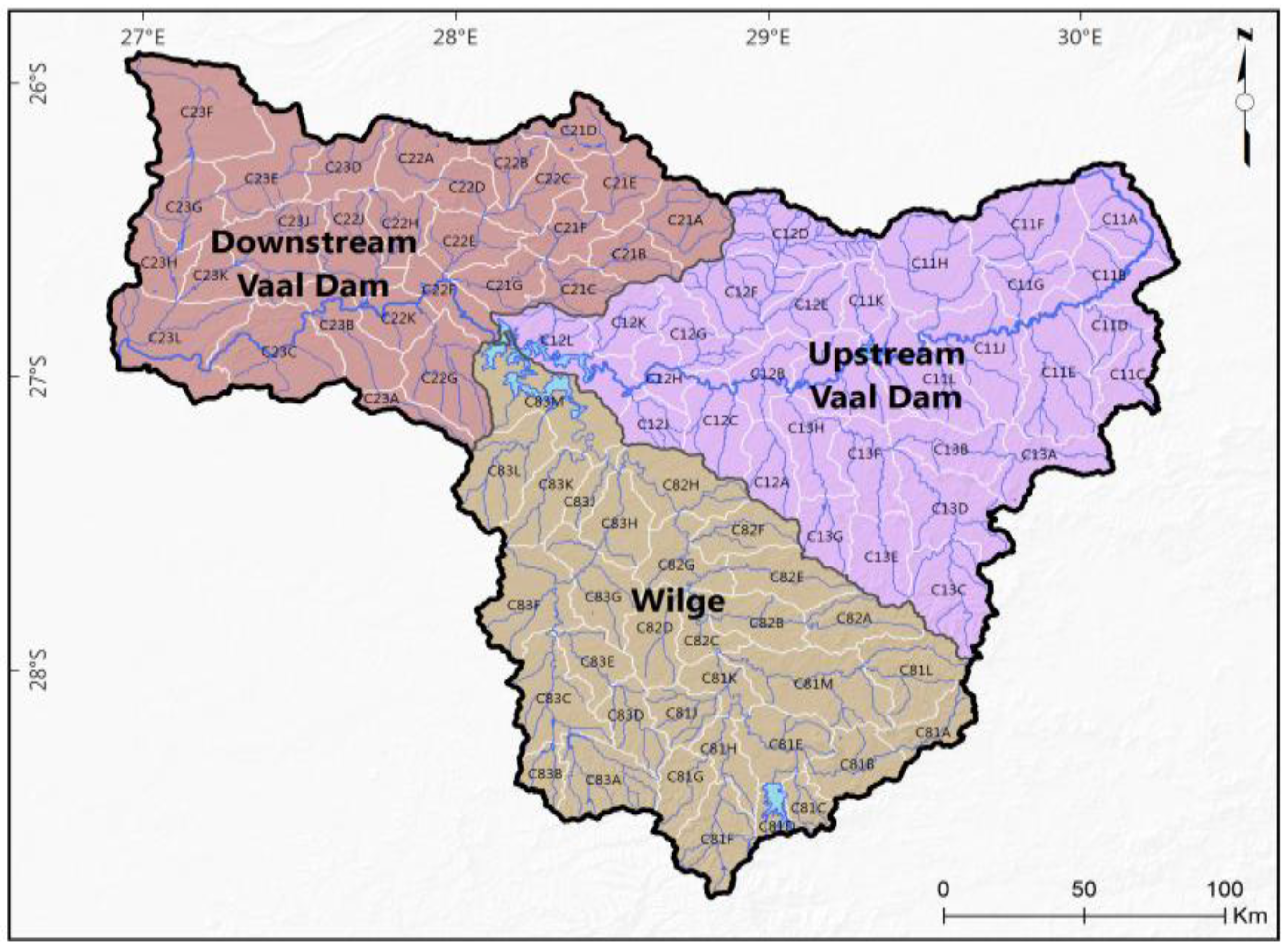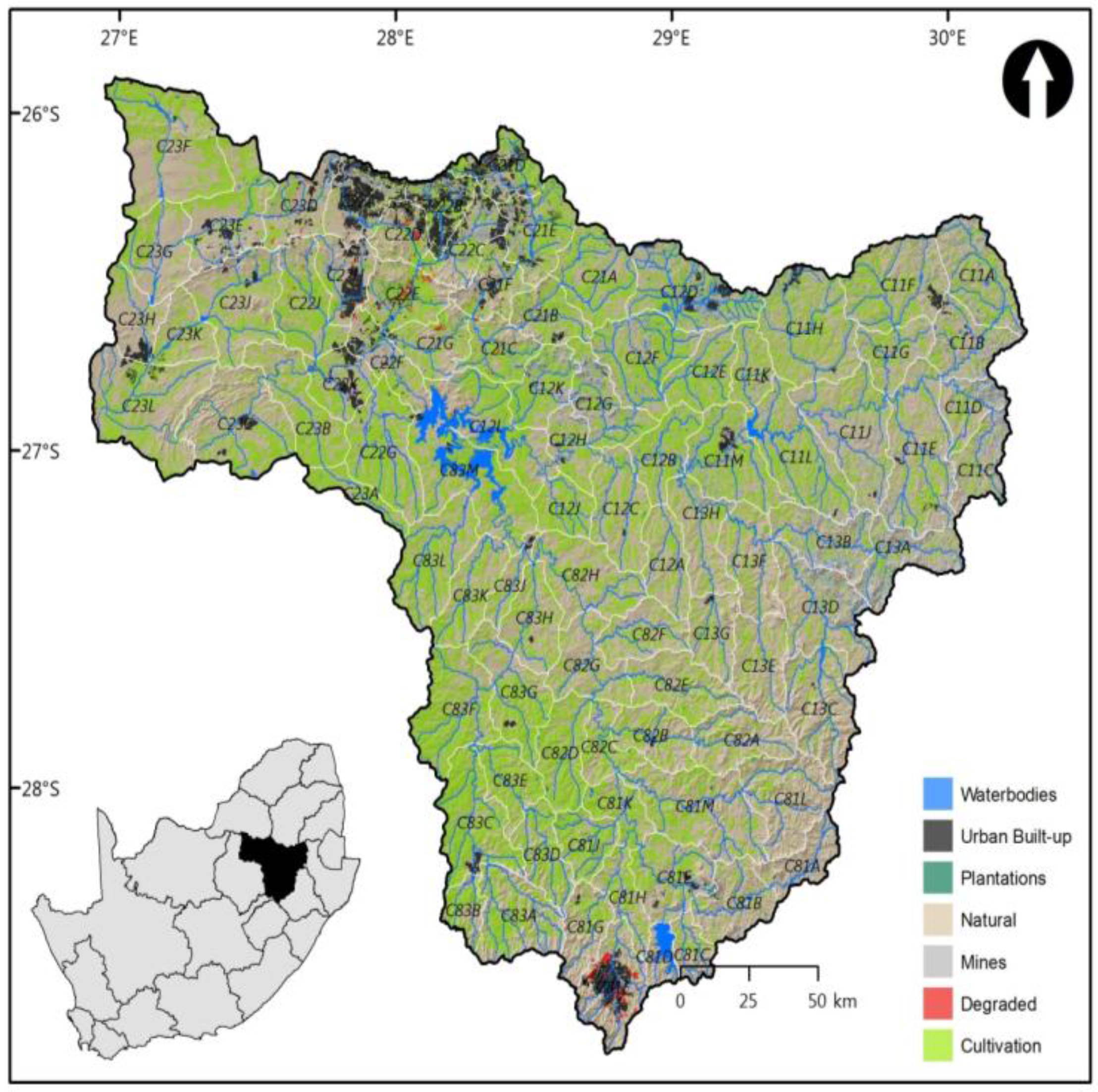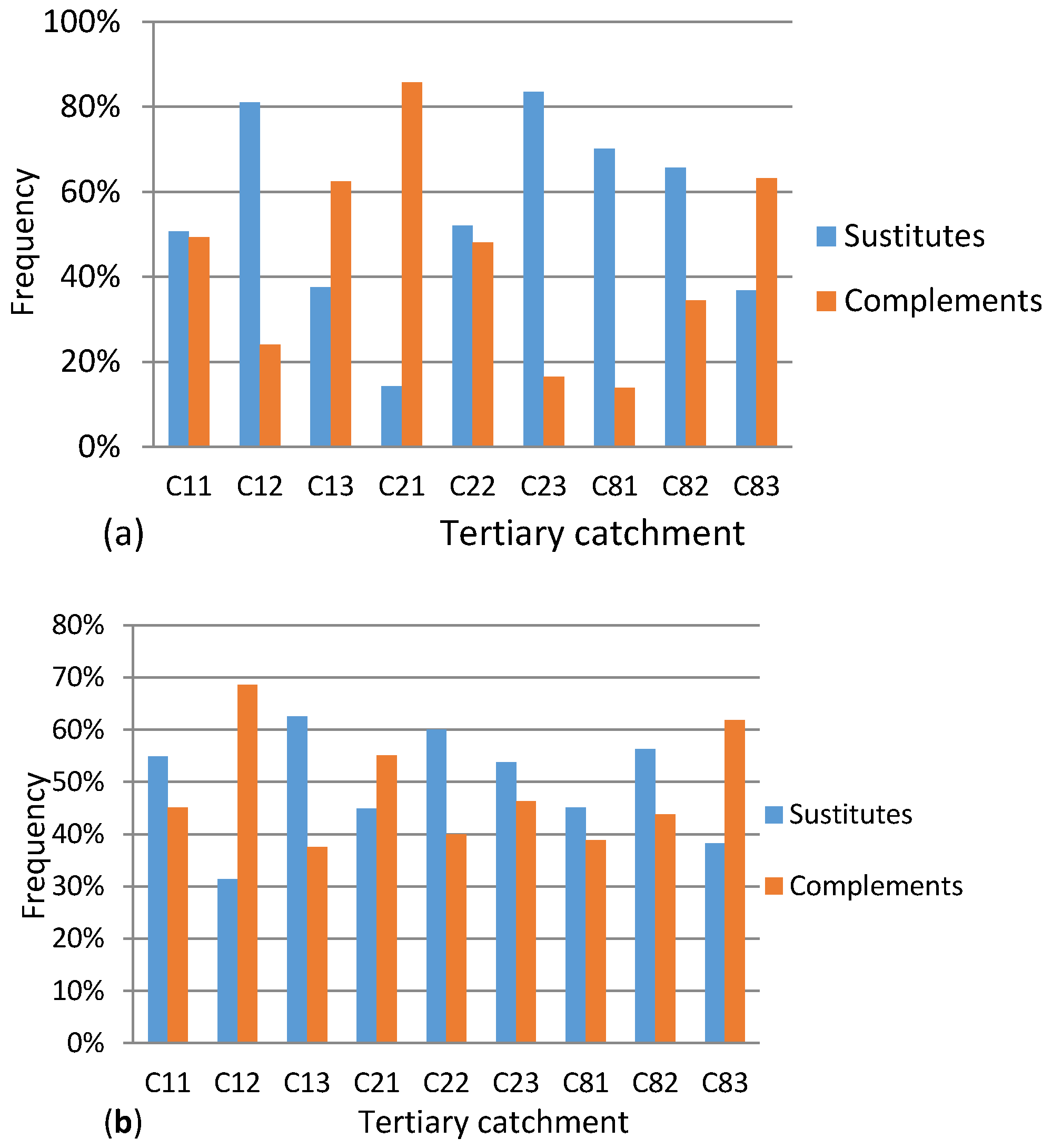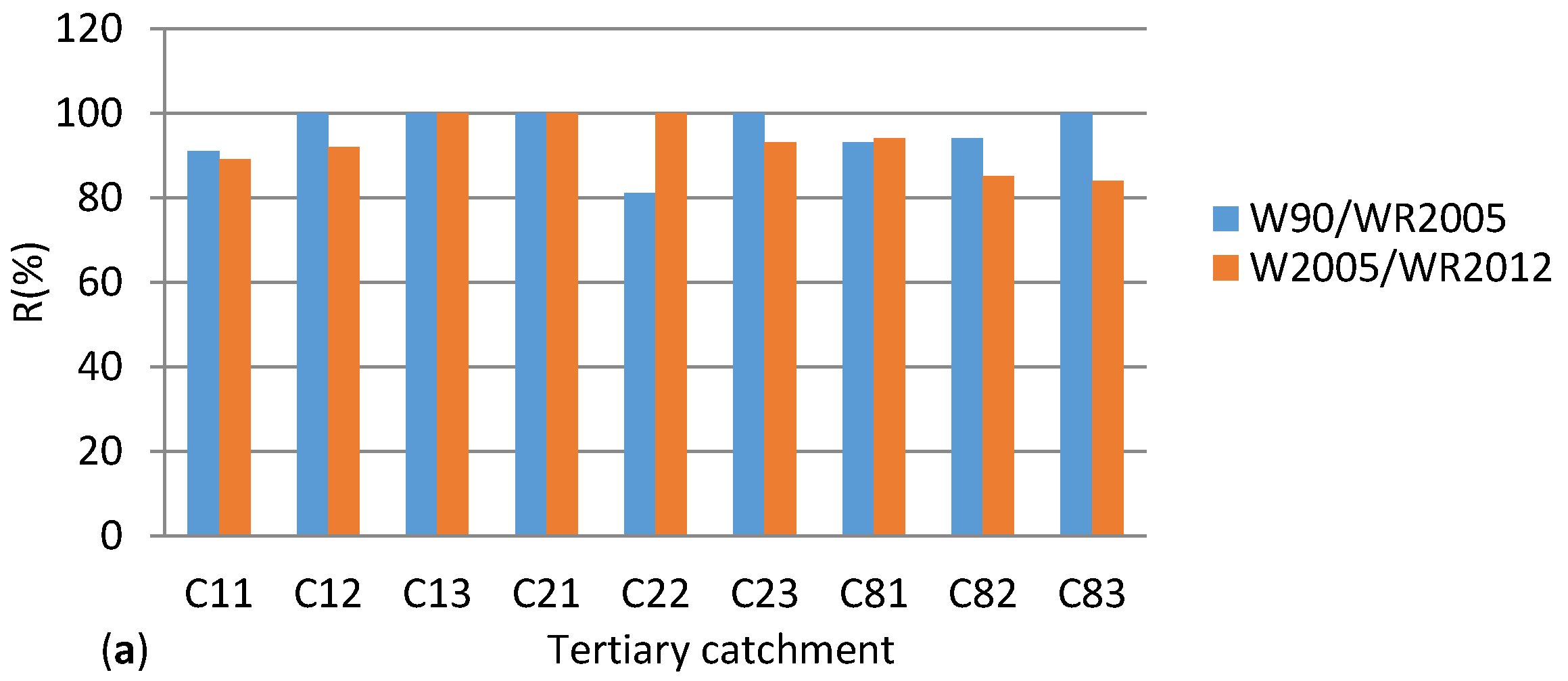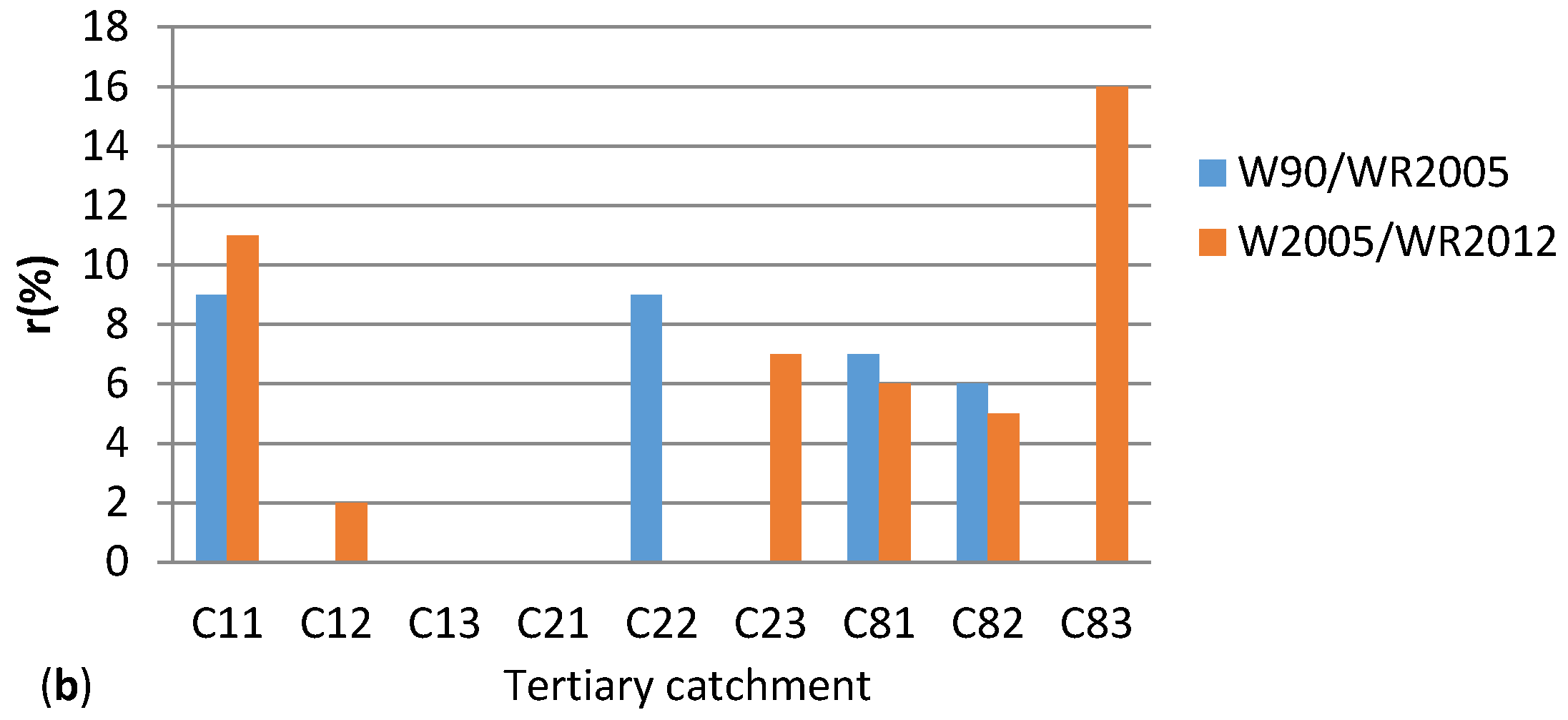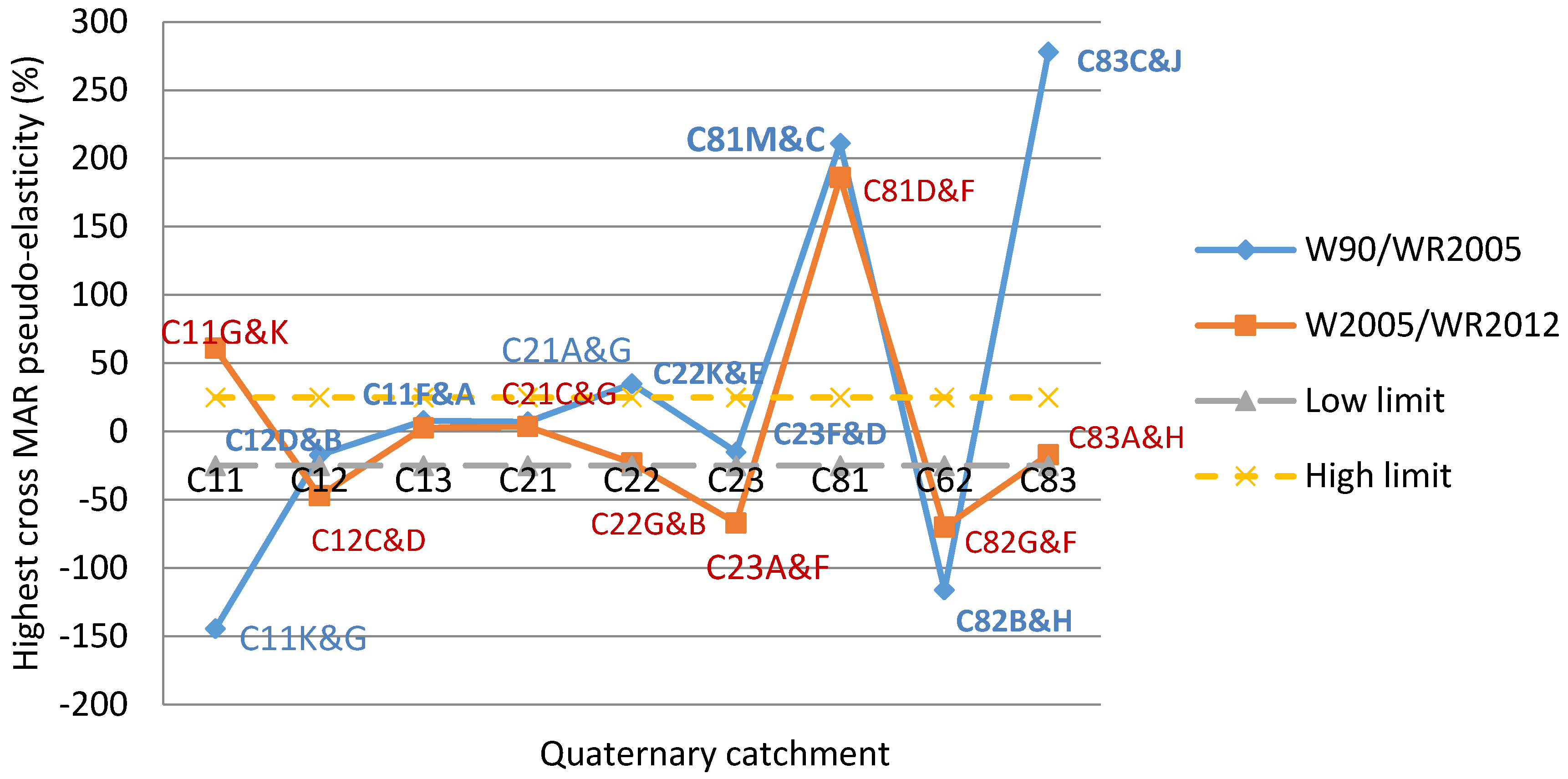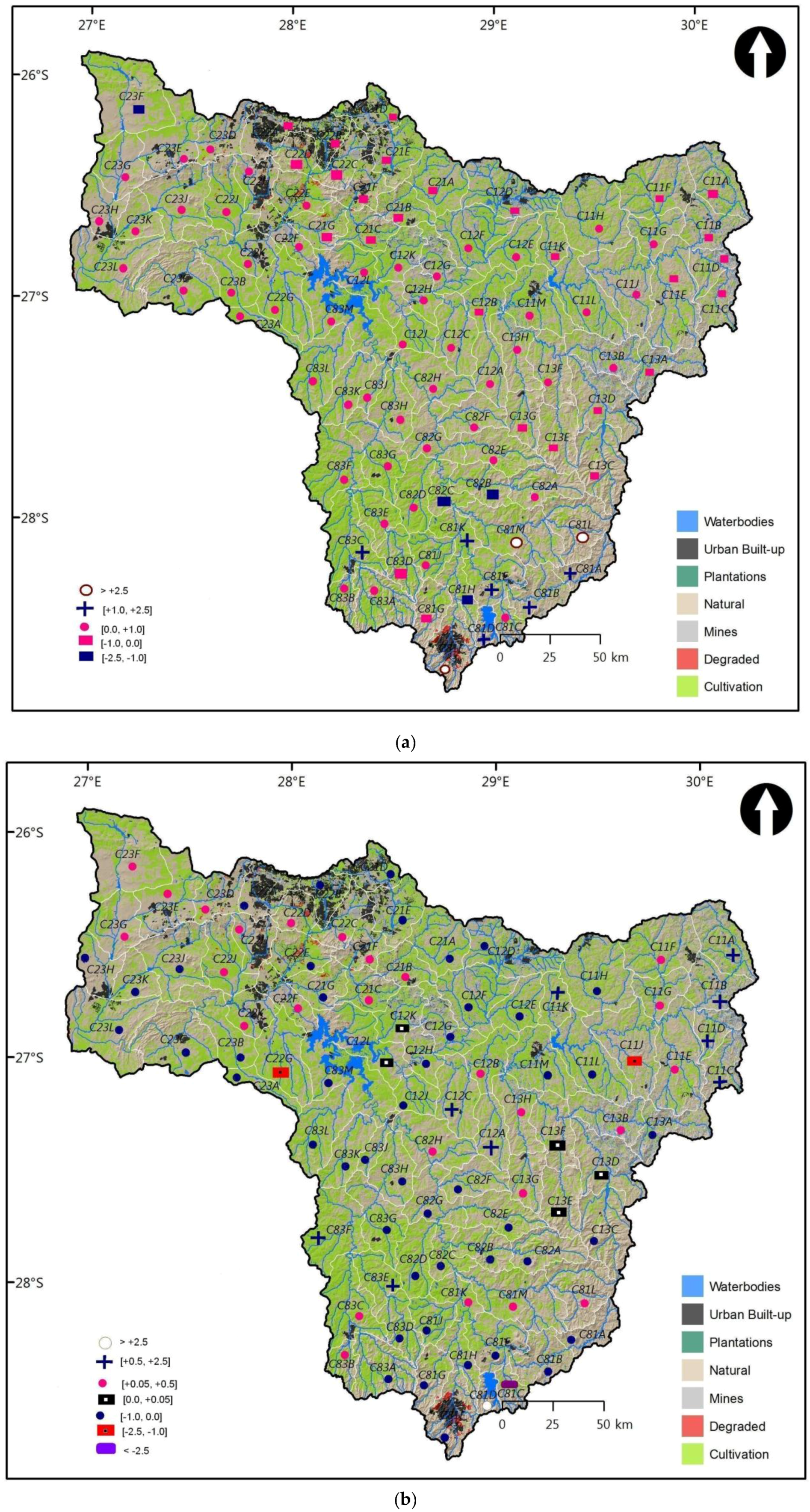1. Introduction
Elasticity, a concept borrowed from economic sciences has been used in hydrology and water resources to determine a relative change in a variable, e.g., rainfall, with respect to the change in runoff generated [
1,
2,
3]. When rainfall is considered to be the most influential variable for generating runoff (e.g., bivariate rainfall-runoff relationships), rainfall elasticity of streamflow is generally positive, i.e., an increase in rainfall is translated into an increase in runoff [
1]. This is contrary to the pure economic law on the price elasticity of demand, which is always negative [
4,
5], however market forces may dictate the sign (positive or negative) of price elasticity [
5,
6]. Nonetheless other parameters have been shown to influence positively or negatively rainfall elasticity of streamflow, e.g., temperature/evapotranspiration [
7,
8,
9], land use, water use [
10]. The notion of elasticity has been linked recently to entropy concept to assess catchment resilience, i.e., mean annual runoff (MAR) pseudo elasticity [
11]. The notion of pseudo-elasticity of entropy was derived for linear regression models and measured the relative change in entropy with respect to the relative change in MAR for tertiary catchments (TC), which are comprised of quaternary catchments (QCs). For the specific case of TCs of the Upper Vaal, MAR pseudo-elasticity of entropy was shown to be relatively positive when considering regression models. In hydrology and water resources, the computation of elasticity is usually related to the same catchment that undergoes change/transformation, i.e., what will be the relative change in runoff/streamflow corresponding to 1% change in rainfall for a given catchment? Likewise, for MAR pseudo-elasticity of entropy, a certain % change in entropy will be associated with 1% change in MAR, for a given catchment. Pseudo-elasticity and elasticity concepts in water related studies could be referred to as self/own-elasticities since changes in the different variables have been formulated with respect to the same catchment. Self/own-elasticity is commonly used to mean elasticity [
12,
13,
14]. Moreover, in hydrology and water resources, elasticity/pseudo-elasticity concept for a given catchment is often defined without the influence of changes in variables from other catchments. The current paper takes this opportunity by assessing how changes in MAR for a given catchment will likely impact on changes in entropy associated with MAR for another (other) catchment(s). Hence this was done by introducing explicitly the notion of cross elasticity of entropy associated with hydrological change (i.e., change in MAR) occurring in two different catchments belonging to the same hydrological region. In this study, the cross MAR pseudo-elasticity of entropy is defined as the ratio between the change in entropy of a given QC and the change in MAR of another catchment. Cross elasticity is assessed preliminarily at the smaller scale of catchment, i.e., QC. Currently, there is almost no literature in hydrology and water resources that deals explicitly with cross elasticity concept. Cross elasticity concept originated from economy, i.e., cross price-elasticity of demand and shows how the change in price of a given good is likely linked to the demand of another good [
12,
13,
14,
15,
16]; as opposed to (self/own)-elasticity, which considers the change in price and demand for the same good. Cross price-elasticity of demand yields complementary goods when price and demand vary in different directions and to substitutable goods when the signs are the same [
13,
15]. Complementary goods and substitutable goods are usually referred to as complements and substitutes respectively [
15,
17]. Cross elasticity concept was later applied to other fields; e.g., transportation [
6,
18], marketing [
13], electricity [
19], etc. The following could also support the introduction of cross elasticity concept in hydrology and water resources:
In the same hydrological zone (TC) and beyond, different QCs are not considered in isolation (hence are interdependent) and are usually subject to activities such as domestic, industrial, social and economic [
20], which are likely to impact on MAR [
11]. For instance exaggerated inefficient water use from one part of the catchment may impact over time on other parts of the catchment, e.g., uneven distribution of water availability coupled with unbalanced water demand/supply; change in MAR, etc.
Water strategy exists to enable proper management and efficient use of water resources in a given region [
21]. Thus an integrated water management resource approach is always required to balance water demand and supply. This is possible only if water is well managed at the smaller scale; i.e., quaternary level, within the TC and that water management takes into consideration of how changes in MAR for one QC is likely to affect the changes in another (other) catchment(s). Water resources could be explored from specific catchments of the region without compromising the sustainability of water resources in the region.
In reality, water transfers can be made intermittently among different catchments, in view of balancing water demand and supply. In a complementary way, water resources could be jointly sustainably used among two or more catchments. These could be seen as “complementary” catchments. Alternatively, water resources from specific catchments could be used to support several activities (domestic, industrial, social and economic) in other catchments. Catchments supplying water could be seen as “substitutes” of those receiving water. A practical example is the Vaal catchment of South Africa (with the Vaal dam) that supplies water from its catchments to several other catchments in Gauteng and beyond. Hence it is a fact that the Upper Vaal catchment impacts on the water balance of several catchments within South Africa and beyond [
20].
Inspired by an economic aspect, e.g., [
5], this study suggested that when water resources from two catchments can be used jointly sustainably to support their activities, the catchments will be referred to as complementary catchments (complements). One catchment could enhance the insufficient yield of another catchment, but not the opposite; hence the former will be seen as “complement” of the latter. When water resources from one catchment are used preferably over another (other) catchment(s) and vice-versa, these catchments will be referred to as substitutable catchments (substitutes). Water resources from one catchment could used to support another catchment, but not the opposite; the former will be referred to as “substitute” of the latter.
In the light of the above, this study investigates preliminarily, the change in uncertainty of MAR for a given QC with respect to the change in MAR of another (other) QC(s), hence cross MAR elasticity of entropy. Climatic conditions and human activities may cause changes in hydrological variables such as streamflow (runoff) [
20,
22,
23,
24,
25,
26], which has been associated with a degree of uncertainty expressed as Shannon entropy, e.g., [
23,
25,
27,
28]. As mentioned earlier, natural climatic conditions [
7,
8,
9,
11,
29,
30,
31] and/or human activities [
10] may influence positively or negatively streamflow elasticity. Nonetheless, naturalized streamflows, thus naturalized MAR plays an important role in South Africa for water resources planning, development and management; hydraulic structure control, natural variability associated with climatic conditions; and ecological water requirements [
32]. Hence surface water resources of South Africa of 1990 (WR90), of 2005 (WR2005), and of 2012 (WR2012) usually present the naturalized MAR data of the different catchments, that include the Upper Vaal catchment. In their derivation, naturalized flows are observed flows adjusted with the net effect of upstream land use changes [
33]. It is also acknowledged that a problem of unknown origin may occur during streamflow adjustments at a given gauge [
33]. Meteorological data with limited human influence could be focused on climatic controls [
31]. MAR is assumed to be relevant to a catchment under virgin conditions, i.e., prior to any human activities that have influenced the hydrology of the catchment [
33]. Therefore naturalized MAR could assume adjustments of observed flows with quantifiably manageable land use changes. For that, cross MAR pseudo-elasticity could be assumed dependent on natural factors, e.g., climatic variations (temperature, rainfall, evapotranspiration), natural vegetation, natural wetlands and aquifers, soil type, topography, etc. Data at QC level is very important since a QC is usually considered as the smallest unit for hydrological studies, at tertiary, secondary and primary level. The Upper Vaal catchment is made of three secondary catchments, which comprise three TCs each. TCs are finally subdivided into QCs.
The implications of cross elasticity (in comparison with self-elasticity) on catchment resilience were assessed in so far as water resources are concerned. Cross elasticity of entropy was applied to the Upper Vaal catchment and the spatial assessment of cross MAR pseudo-elasticity at QC level, which is fundamental for tertiary and secondary catchments, was also investigated. It is noted that the assessment of spatial
distribution (
variation) of rainfall elasticity of streamflow [
2,
3,
7,
8,
9,
29,
30,
31], and entropy associated with streamflow [
22,
23] and with precipitation [
34,
35,
36,
37] have been documented. The use of maps for the spatial distribution analysis of the catchment under investigation, is common. This study is built on MAR pseudo-elasticity concept that was introduced recently [
11]. It is a preliminary study that investigates cross MAR pseudo-elasticity concept within TCs. It is natural to consider QCs, which constitute a TC. It does not deal yet in detail with cross MAR pseudo-elasticity among TCs, within secondary catchments. Hence a separate study should be conducted at secondary level to determine the impact of change in entropy of a TC with respect to the change in MAR at another TC. Moreover, the individual as well as the combined effect of natural factors on cross MAR pseudo elasticity could be further investigated.
The paper is organized as follows: the first section gives an overview on cross elasticity, which focuses on cross price-elasticity concept from economics, as compared with elasticity (self-/own-elasticity). Main characteristics of the concept are given and its applications to other fields are outlined. The second section explores the main characteristics of cross-elasticity and extends the concept to hydrology and water resources, by focusing preliminarily on the change in MAR and its uncertainty (entropy), hence cross MAR pseudo-elasticity of entropy. MAR is a very important hydrological variable. The third section gives the methods for assessing cross MAR elasticity of entropy and its implication for catchment resilience/sustainability of water resources. The fourth section applies the methods to the Upper Vaal catchment; hereby presents the results and discussion on cross MAR pseudo-elasticity, by outlining the implications on hydrological resilience. The last section summarizes the findings from the previous section and presents recommendations and outlines further research.
In what follows, the prefix pseudo will be sometimes omitted from elasticity. Self/own-elasticity will mean elasticity as compared to cross elasticity. Hence cross MAR pseudo-elasticity will often mean cross MAR elasticity. MAR will mean naturalized mean annual runoff. Complementary catchments and substitutable catchments will be referred to as complements and substitutes respectively. Uncertainty and entropy could mean the same. Upper Vaal, Upper Vaal catchment and Upper Vaal region will be used interchangeably.
2. Overview on Cross Elasticity Concept
From an economic point of view, price-elasticity has been defined as the change in the demand of a good (brand) over the change in price of the same good [
14,
15]. Elasticity is referred some times to as self- or own-elasticity [
13,
14], since these changes are assessed with respect to the same good (brand). When changes are assessed with regard to two different goods, the term cross price-elasticity is used; i.e., how the demand of a good is linked to the change in price of another good [
5]. The importance of cross price-elasticity has been shown to give power to the consumer for switching to other brand(s), when one good becomes unaffordable or rare, for instance [
13,
15].
Some of the important characteristics of cross price-elasticity are as follows: firstly a positive cross elasticity between two brands shows that these brands are substitutable; secondly brands are complementary when their cross price-elasticities vary in opposite direction (i.e., negative) [
5,
14]; and lastly the two brands do not compete at all when their cross elasticities are null [
15]. These characteristics among brands are referred to as substitutability, complementarity and independence respectively [
15]. The context of the market determines the extent to which substitutable, complementary goods could both appear together in the perpetual space [
15]. It was shown also that a good (palm oil) could be a substitute for another good (soy oil) and not the opposite [
5]. In specific situations, complementarity can be related to the purchase of two goods on a single buying opportunity, while substitutability can be related to switching between goods of interpurchase times [
15]. The higher the cross elasticity between two brands, the more correlated the goods should be [
13,
14,
15]. Results on cross-elasticity are usually summarized into a matrix called self and cross elasticity matrix; which was shown to be asymmetric generally with the upper left diagonal of the matrix being the line of asymmetry, for which the diagonal entries are self-elasticities [
14,
38]. The strength of a brand with respect to the interbrand price competition is measured by the amount of asymmetry [
17]. In exceptional cases, constraints could be imposed to have a symmetric cross elasticity matrix [
17,
39].
These characteristics are so appealing that they were adapted to the case of water resources sustainability; in particular catchment resilience assessed using entropy associated with MAR. For instance, water managers could decide to switch to a water surplus catchment to ensure good water demand/supply balance in the region (substitutability). Hence water transfers among different catchments could be possible for water sustainability of the hydrological region. Water managers could also decide to use jointly water resources from different catchments (complementarity). Water transferred from one catchment to another catchment and possibly vice-versa, may not be necessarily the same (asymmetry); hence the impact of change in MAR of a catchment on entropy of another catchment and vice-versa may not necessarily be the same. MAR is one of the important hydrological variables for catchment resilience or water resources sustainability since the yield of a catchment depends on MAR [
11]. Hence for the purpose of the current study, cross MAR pseudo-elasticity was used to assess how changes in uncertainty for a given catchment were possibly linked to changes in MAR for another catchment, within the same TC. In line with Ilunga (2017), the link between cross elasticity concept and catchment resilience in terms of water resources sustainability, was determined by using the concept of linear zoning of catchment resilience. Similar to selected studies on entropy of streamflow [
22,
23], entropy of rainfall [
35,
36,
37] and in particular rainfall elasticity of streamflow [
2,
3,
7,
8,
9,
29,
30,
31], spatial distribution (variation) assessment of cross MAR pseudo-elasticity across the Upper Vaal catchment was carried out by using a map representation. This is a preliminarily study that introduces cross MAR pseudo-elasticity of entropy at QCs level within a TC and could be further extended to TCs within secondary catchments.
3. Cross MAR Pseudo-Elasticity in Hydrology and Water Resources
The literature of cross elasticity concept is almost inexistent in hydrology and water resources. As outlined earlier, MAR pseudo-elasticity of entropy concept has been introduced recently [
11] and on which cross-MAR elasticity is built. A bivariate model (i.e., linear model) was used to derive MAR pseudo-elasticity of entropy for the different TCs of the Upper Vaal catchment. In particular, MAR pseudo-elasticity was interpreted as the regression coefficient of the linear regression. MAR pseudo-elasticity of entropy (
εi) was defined as the ratio between relative changes in uncertainty associated with MAR and changes in MAR for different QCs of a given TC.
It is useful to give important equations that are critical in the determination of cross MAR elasticity as adapted from Ilunga [
11].
Equation (1) below is derived from the Shannon entropy index of the variable
zi, and shows the uncertainty associated with
zi. Entropy can be written as
H(
zi). The variable z
i can be MAR for a specific
ith QC in a given TC. The
i values (
i = 1, 2, 3, …,
k) represent the
i QCs in the TC of the Upper Vaal catchment . Each QC contributes to the total MAR of their TC.
In Equation (1), the base of the logarithm is the unit of H(zi). It is in bits if the base is 2, in Napiers if the base is e, and in decibels (dB) if the base is 10. If Z is MAR of the TC in either WR90, 2005 or WR2012 data set, therefore .
For a specific
ith QC in a given TC, the relative change/variation in MAR and relative change in entropy are given by Equations (2) and (3) respectively as shown below when using W90 and W2005 data sets:
where
δ(
zi),
δH(
zi) are the relative change/variation in MAR and relative change/variation in entropy for a specific
i-th QC respectively. The variable
zi is MAR as defined earlier.
Similar Equations to (2) and (3) can be established for WR2005/WR2012.
For hydrological changes occurring between 2 data sets, the MAR pseudo-elasticity for the
i-th QC of a given TC, is given by Equation (4):
where
δHi is the relative change in entropy associated with MAR;
δi is the relative change in MAR for the
i-th QC in the TC.
Equation (4) can be referred to as self/own-MAR pseudo elasticity of entropy for the
i-th QC since changes in the equation are defined with reference to the same
i-th QC. Changes are expressed in relative terms. Hence cross MAR pseudo-elasticity (
εij) can be defined as the ratio between the change in entropy of
i-th QC and the change in MAR of
j-th QC. Hence cross MAR pseudo-elasticity (
εij) is given by Equation (5):
Equation (5) determines the % change in entropy of i-th QC associated with a 1% change in MAR of the j-th QC.
Conversely, cross MAR pseudo-elasticity (
εji) is the ratio between the change in entropy of
j-th QC and the change in MAR of
i-th QC. This is translated into Equation (6) as given below:
The terms in Equation (6) can be defined in a similar way as in Equation (4).
In hydrology and water resources studies, rainfall elasticity of streamflow [
1] and MAR pseudo elasticity of entropy for bivariate relationships [
11] were generally positive. This is not in line with the ideal economic law of the price-elasticity of demand, which is negative [
4,
5]. However, other hydro-climatic variables (i.e., temperature and evapotranspiration) [
9] and human activities (i.e., land use, water use, etc.) [
10] could impact positively or negatively rainfall elasticity. Pseudo-elasticity of entropy varied in opposite direction with mean annual evaporation, and in the same direction with mean annual precipitation for TCs of the Upper Vaal [
11]. A positive MAR pseudo-elasticity of entropy means that an increase/decrease in entropy is associated with an increase/decrease in MAR. A negative MAR pseudo-elasticity of entropy implies the variations in entropy and in MAR are of opposite signs. Similar to economic concept, two catchments will be said “complements” in terms of water resource sustainability, when the cross-MAR elasticities are negative. The sustainability of water resources is characterized by the level of catchment resilience defined with respect to the uncertainty associated with MAR [
11]. Complementarity refers to the increase/decrease in entropy for one catchment, linked to the decrease/increase in MAR for another catchment and vice-versa. Hence water resources could be used jointly from the 2 catchments to balance water demand/supply. When cross MAR elasticities are positive, QCs could be regarded as substitutes, in terms of water resource sustainability (catchment resilience). In this case, water transfer between different QCs could also be promoted to balance water demand/supply. Substitutability is referred to the increase/decrease in entropy for one catchment linked to the increase/decrease in MAR for the other catchment and vice-versa. There could be a situation where one catchment could be a substitute/complement for another catchment, but not vice-versa [
5]. Complementarity and substitutability for different QCs should always be comprehended within the zone of acceptable uncertainty (entropy), i.e., the zone of functioning resilience associated with MAR. The zone of acceptable uncertainty that defines catchment resilience was determined by the interval (10%, 25%) increase/decrease for pseudo elasticity; when considering a change in 10% MAR [
11]. That is, MAR pseudo-elasticity of entropy should vary between −25% and 25%. This interval was confirmed valid when a statistical analysis was conducted on the significance of MAR pseudo-elasticity, within the context of linear regression. Hence, the cross MAR elasticity of entropy associated with MAR could be assumed acceptable, if it could fall into the above-mentioned interval.
The following could also enhance the introduction of cross MAR elasticity concept:
At a lower scale, the different QCs in a TC are not considered in isolation or may have a certain level of interdependence, as far as water resources are concerned. Streamflows from one catchment may have an impact in one way or the other on the runoff of another catchment. This interdependence may cause a change in runoff in the different catchments and change in uncertainty associated with MAR. For example surrounding catchments of the Vaal dam catchments may contribute to the inflow into Vaal dam. In return, water stored in the Vaal dam will be supplied and contribute to several activities in the QCs of the TCs and beyond.
At a relatively larger scale, water transfers can be made among different water management areas, in view of balancing water demand and supply between two or several catchments, i.e., in the Upper Vaal, water resources should be well managed and co-ordinated with other interdependent catchments, in a way to have an integrated water resource system [
20]. Hence, there is a need for water resources to be properly managed strategically at the smaller scale; i.e., quaternary level, within the TC as well as at a larger scale such as secondary and primary catchments. Water management should take into consideration of how the change in MAR of a given catchment is likely to affect the change in uncertainty associated with MAR in another catchment, within the same hydrological zone and beyond.
6. Conclusions
For the first time, cross elasticity concept has been extended to hydrology and water resources using entropy concept; i.e., cross MAR pseudo-elasticity of entropy. The level of linkage between changes in MAR and changes in entropy of another (other) catchment(s) was established in the Upper Vaal. The analysis of cross MAR pseudo-elasticity of entropy was carried out on surface water resource data sets; i.e., WR90, WR2005 and WR2012. These data were in their naturalized form when extracted from WRC database and this could assume there was little influence of the human factor. Climatic controls could be associated with these data [
36] as far as cross MAR elasticity was concerned. Thresholds of a linear resilience zoning [
11] were extended to the assessment of cross elasticity values. The notion of cross MAR pseudo-elasticity was shown as a fair tool to assess the complementarity and substitutability for the different QCs of the TCs in the Upper Vaal region. That is, the use of water resources for some QCs could be done jointly, while in some cases, water transfer between QCs could be an option to sustain the yield (or water resources) from selected QCs, in a way to balance demand/supply in the region. However, the Wilge sub-region of Upper Vaal displayed promptness to water resources vulnerability in fewer QCs. Cross MAR elasticity characterized the correlation strength between QC pairs (weak versus high cross elasticity) to determine the resilience of catchments. Resilient QCs (in terms of water resources) displayed relatively weak cross elasticity values as opposed to vulnerable QCs, which were characterized by high cross elasticity values. In particular, instances of cross elasticities, close to 0 were observed; showing that a variation of MAR for a given QC was insignificant to cause an opposite variation in entropy for another QC. Although the resilience was acceptable in most cases, it was revealed that in some instances some QCs displayed very strong correlations. For instance, the global highest cross MAR elasticity of entropy was located in the TCs C83, followed by C81 and could go above 100% in magnitude for specific QCs. This implied that decision-makers could pay attention to water resources planning and management, and control of water infrastructures. A spatial analysis conducted on cross MAR pseudo-elasticity revealed that, in general, there was a fair distribution of complementary and substitutable QCs in the TCs. In most cases, the latter were dominant as compared to the former. Hence, this supported that water transfers between the different QCs and beyond could prevail in the Upper Vaal as it is the current situation [
20]. However, this analysis did not give more information on the cross MAR elasticity differences related to the natural characteristics of the catchments. In general, it found out that the level of assurance to sustain water resources was relatively acceptable; hence low vulnerability risk of water resources, generally less than 20%. Overall, cross MAR elasticity for QCs of the Upper Vaal region yielded the zone of tolerable entropy.
However, it should be noted that entropy through cross MAR elasticity does not show how complementary or substitutable QCs should be managed and operated, a different time scales. The concept of cross MAR pseudo-elasticity was built on MAR pseudo-elasticity, therefore it considered only one parameter; i.e., MAR. Therefore, the inclusion of variables other than runoff, such as temperature, evaporation, precipitation should be investigated. This is a preliminary study dealing specifically with the intra-tertiary catchment assessment of cross MAR elasticity for QCs. Further work could be done on cross MAR elasticity between TCs within secondary catchments and on the assessment of its implications on the Upper Vaal catchment resilience and beyond. The impacts of climatic parameters on cross MAR pseudo-elasticity and other natural conditions associated with soil type, topography, natural vegetation, natural water storages and wetlands, could be investigated. Similar to previous studies on hydrological elasticity [
2,
7,
8,
9,
11,
29,
30,
31], the impact of these factors on cross elasticities investigated individually (bivariate relationships) could be different when these impacts are considered simultaneously in a multivariate configuration. The effect of unquantifiable land use changes should be taken into consideration. The combined effect of natural conditions, together with human activities such as land use, water use, etc. could impact positively or negatively on cross MAR pseudo-elasticity and would need to be also researched when historical data are considered. The concept should be investigated when considering runoff data of different time scales, i.e., monthly, seasonal, and annual, etc. The inclusion of parameters other than MAR in the determination of catchment vulnerability risk should be investigated. The linkage between cross MAR elasticity and the existing cross entropy concept could also be researched.
